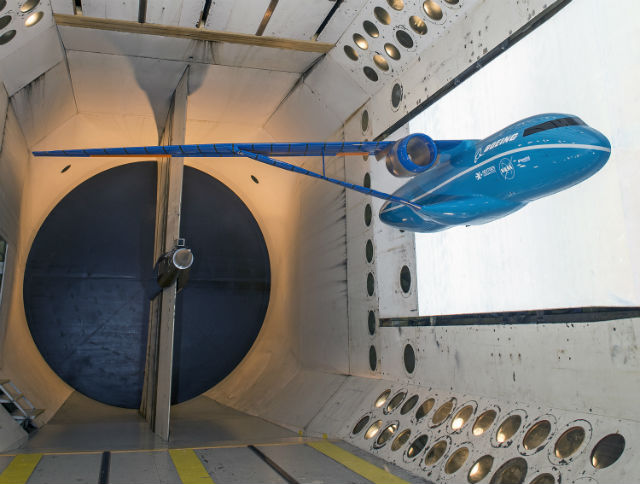Five aircraft demonstrator programmes launched by Boeing's commercial division since 2001 all share a defining characteristic: an ordinary aircraft modified or stuffed with brand-new technologies.
Leveraging aircraft already in production as the demonstrator platforms has allowed Boeing's product development organisation to focus on testing dozens of potential new technologies. But that policy also limits Boeing’s experiments to the classic "tube and wing" configuration, excluding possibly more fuel-saving alternative designs.
As Boeing begins to plan for a future round of ecoDemonstrator testing, company officials will consider breaking from the traditional platform to designing, building and flying a new prototype aircraft that features an unconventional approach to integrating the airframe and propulsion system.
"If we're going to be planning [ecoDemonstrators] every year, every two years – and if I want to start thinking today about a 2020 ecoDemonstrator – I'm not limited then to the paradigm of using an existing production airplane," Boeing vice-president of product development Mike Sinnett tells Flightglobal.
"You could imagine one of many partners that could help us build a prototype airplane at a cost structure that, even if it was subscale, could demonstrate some of those other configurations."
The classic jet-powered airliner configuration – an oval or circular fuselage with podded engines tucked under a low-slung wing – has stayed remarkably stable, despite nearly six decades of incremental design improvements. As aircraft designers look two or three decades into the future, however, different configurations are becoming attractive.
Boeing has proposed several alternative configurations, including a truss-braced wing. The truss diagonally attaches to the underside of the wing and the belly of the fuselage.
By providing structural support, the truss allows the wing to be thinner and longer. Such shapes produce weaker wingtip vortices, which reduces induced drag, and increases the wing area covered by laminar flow, which leads to better aerodynamic efficiency. Despite the extra drag and weight caused by the diagonal truss, the improved wing can reduce overall fuel consumption by 5-10%, a joint NASA-Boeing study concluded earlier this year.
A truss-braced wing design is an "area of interest" as Boeing considers options for a flying ecoDemonstrator after 2020, Sinnett says.
"In the 2020 timeframe, if we were going to do a prototype then we'd have to be working on it, the design of it, in the next two to three years," Sinnett says. "If I were going to prioritise what I would want to know in that timeframe, I'd want to know as much about the high-aspect ratio cantilever truss brace as I could and I wouldn't necessarily want to throw a whole bunch of other stuff into the mix. So I would be looking at a relatively simple tube but really trying to go after the benefits of a scaled-up truss-braced wing."

A truss-braced wing can reduce overall fuel consumption by 5-10%, a study concluded earlier this year
Boeing
Mindful that market preferences can swing abruptly, Boeing is keeping its options open, with more than five years remaining before a potential prototype becomes reality. Sinnett recalls how the economic impact of terrorist attacks in September 2001 caught the company's product planners off guard, forcing them to switch from the Sonic Cruiser to the slower, more efficient 7E7 concept – later renamed the 787 – within two years.
Any future ecoDemonstrator prototype will reflect the technology needed to support Boeing's long-term product strategy. Sinnett cites developing regional, point-to-point markets as an example of how the company analyses its needs for technology demonstrators. Ultra-long-range aircraft require higher speeds, which drives designers to look for improvements in swept-wing configurations. An aircraft optimised for regional flying, by contrast, has different performance drivers.
"In a regional market – if you're trying to develop that – then speed may not be as important and then alternate configurations with less swept wings start making more sense, because the speed doesn't matter over the shorter distances," Sinnett says. "Depending on how the market plays out, that may or may not be an important thing if the emphasis in the next 10 years turns into more regional and medium-range routes."
Source: Flight International























